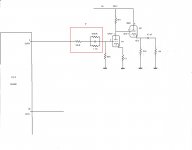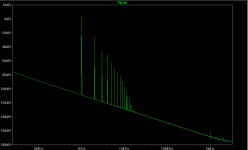In short, to make the sound sounds "good" just distort it in an adequate manner.
The sound of any gear is not just dependent upon how much distortion it has but the circuit as a whole. You could simplify the device as a black box and give it in and out properties.
Many of the earlier Fender guitar amps had a common cathode 12AX7 triode direct coupled to a cathode follower. I call this circuit a "full-wave saturator" since, if designed properly, both the positive and negative clippings are a result of saturation rather than cutoff. Cutoff has sharp corners and is relatively consistent, as opposed to saturation which has rounder corners and is effectively modulated (shape changes more with signal level and frequency). For guitar distortion, saturation distortion sounds better than cutoff distortion. Using this topology in a Hi-Fi would perhaps bring up the second harmonic a bit, depending on a bunch of variables. I'd guess that was the intention.
Many of the earlier Fender guitar amps had a common cathode 12AX7 triode direct coupled to a cathode follower.
Ah yes the 5F6-A Bassman............where Jim Marshall got his signature sound from😀
The sound of any gear is not just dependent upon how much distortion it has but the circuit as a whole. You could simplify the device as a black box and give it in and out properties.
For instance my cdp originally sounds "good", it was tweaked I found its sounds "better". There were no change in the servos, no change in clock, no change in the DAC. But the audio after the DAC is filtered & amplified (at this level I should have the original sound more or less) but the tweaked amp was designed to distort the sound and then my tweaked cdp sounds "better" for me. The difference is just distortion. Sorry for my English, hope that you see what I mean.
With the comments of Bob Richards I am more and more convinced that the tweaker was inspired in his design by guitar amps
In your case, and this specific example yes the added distortion has a positive affect on your listening experience. What I am saying is you can't just add distortion to everything expecting the same results.
Here is a good explanation of what is going on with direct coupled cathode followers. The Valve Wizard
Here is a good explanation of what is going on with direct coupled cathode followers. The Valve Wizard
That Valve Wizard page is excellent. There's talk that the diode and resistor safety addition R1 and D1 could cause some distortion if the diode leaks a little with reverse bias, so in Hi-Fi land it's frowned upon. So is the topology in general for many, since it produces distortion. I didn't know the cathode bias cap could contribute to blocking distortion which makes a fizzy sound. Always good to learn something new.
The thing to keep in mind is that any distortion mechanism that generates a significant and dominant 2nd harmonic (generally always a good sounding thing), also increases I.M. distortion. Lots of 2nd harmonic sounds good on simple sounds (acoustic guitar and singer), but may be objectionable when listening to more complex sounds with many instruments playing simultaneously, especially a chorus (group of people singing together - not the guitar effect), or similar things where the I.M. distortion causes a difference frequency to be generated that will modulate the overall sound like a slight "warble" effect. There's a fine line where you've got just the right amount, depending on your goal. In a Hi-fi I would want a fast rolloff of harmonic distortion products, with the 2nd harmonic being higher than the third if possible, but very little warble effect with a chorus singing group (I think piano is real sensitive to this too). In guitar land, I'd prefer to have an audible difference beat frequency (I.M. product) occur when pushed hard for a great bluesy distortion, but not too much.
The thing to keep in mind is that any distortion mechanism that generates a significant and dominant 2nd harmonic (generally always a good sounding thing), also increases I.M. distortion. Lots of 2nd harmonic sounds good on simple sounds (acoustic guitar and singer), but may be objectionable when listening to more complex sounds with many instruments playing simultaneously, especially a chorus (group of people singing together - not the guitar effect), or similar things where the I.M. distortion causes a difference frequency to be generated that will modulate the overall sound like a slight "warble" effect. There's a fine line where you've got just the right amount, depending on your goal. In a Hi-fi I would want a fast rolloff of harmonic distortion products, with the 2nd harmonic being higher than the third if possible, but very little warble effect with a chorus singing group (I think piano is real sensitive to this too). In guitar land, I'd prefer to have an audible difference beat frequency (I.M. product) occur when pushed hard for a great bluesy distortion, but not too much.
What I am saying is you can't just add distortion to everything expecting the same results.
Yes I got it. Thanks for the link to the very interesting Valve Wizard page.
Here is the schematic of a DAC output stage sent to me by a friend who owns this DAC. The DAC was fully designed by the same guy who tweaked by cdp. The schematic is trustworthy except what is inside the redbox which is not important for our discussion.
It can be seen from this schematic that the grid voltage is slightly more positive than the cathode voltage. It would be insteresting to see the distortion figures of this schematic if you can simulate it but I think there would be no surprise.
Attachments
I'm new to using tubes at low B+, but I'd worry about modelling programs being accurate in such a case. I'd build it up and look at it with a scope, and also with a spectrum analyzer if possible. I've read that low B+ means the plate resistance becomes higher, and yet the plate load resistors in actual low B+ circuits are quite a bit lower in value than is normal for high B+. That seems backwards to me, suggesting very high I.M. distortion.Yes I got it. Thanks for the link to the very interesting Valve Wizard page.
Here is the schematic of a DAC output stage sent to me by a friend who owns this DAC. The DAC was fully designed by the same guy who tweaked by cdp. The schematic is trustworthy except what is inside the redbox which is not important for our discussion.
It can be seen from this schematic that the grid voltage is slightly more positive than the cathode voltage. It would be insteresting to see the distortion figures of this schematic if you can simulate it but I think there would be no surprise.
It would be insteresting to see the distortion figures of this schematic if you can simulate it but I think there would be no surprise.
Ye asks and ye shall receive. THD 3.93%
I'd build it up and look at it with a scope, and also with a spectrum analyzer if possible.
I would love to do this but for now a simulation will have to do.
Attachments
Thanks for the simulations, you did it very fast !! I wish I could be able do such simulations myself. Results are similar to the original schematic of my cdp right ?
If you are interested I can give my cdp to a friend and ask him to look at the output stage with a spectrum analyzer and post the results here. I already have the general idea with the simulations. I will try someday the tube/Mosfet topology with and without distortion but I know what will be the result 😀 You want good sound distort it 😀😀 (joking)
I did not expect that I can learn so much from a simple dust cleaning I should do it more oftenly. I am happy to learn why my tweaked cdp sounds "good" to me. I do not use it for classical music but for pop, rock, jazz, blues....you hear the play of the bass guitar very distinctly, percussions are very powefull.
Cheers from France and thanks to all of you for the valuable information,
If you are interested I can give my cdp to a friend and ask him to look at the output stage with a spectrum analyzer and post the results here. I already have the general idea with the simulations. I will try someday the tube/Mosfet topology with and without distortion but I know what will be the result 😀 You want good sound distort it 😀😀 (joking)
I did not expect that I can learn so much from a simple dust cleaning I should do it more oftenly. I am happy to learn why my tweaked cdp sounds "good" to me. I do not use it for classical music but for pop, rock, jazz, blues....you hear the play of the bass guitar very distinctly, percussions are very powefull.
Cheers from France and thanks to all of you for the valuable information,
- Status
- Not open for further replies.
- Home
- Amplifiers
- Tubes / Valves
- Unsual use of triode?

